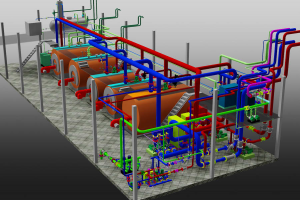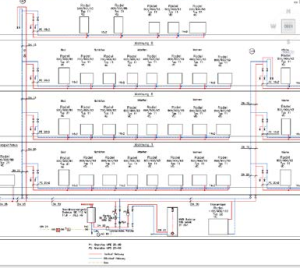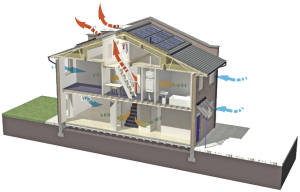Heating planning
The AXONCAD office will be happy to assist you with your heating planning:

As a planning office for HKLS, we are your reliable partner in the field of heating planning. Our team consists of qualified and motivated professionals with many years of experience. Thanks to our skills, your tasks will be completed quickly, efficiently and on time. The AXONCAD building technology engineering office (TGA) carries out HOAI phases 1-6 of the architectural design. Depending on the complexity of the project and the customer’s wishes, the order can be carried out in full or in separate steps.
- Heating planning
- Heating load calculation
- Heat pump planning
- Pipe network calculation
- 2D, 3D drawings
Heating Services

Our office offers design in the field of heating technology and we can create a project for you and carry out all the necessary calculations. The heating system is a complex technical system, on the reliable operation of which the comfort, safety and the possibility of living in the room in winter depend. In order for the system to work efficiently and without failures, to be economical and reliable – it is necessary to carry out the design of the heating system. Savings on well-planned projects can lead to unjustified costs.
The reliability of technical communications has always been valued, but now energy efficiency and comfort are also coming to the fore. The heating systems used are becoming more complex and expensive, they are automated and closely interact with each other. It is practically impossible to adopt standard designs without significant changes, the heating system is almost always custom-made.
The heating system is the most expensive technical system of any building. It requires about 5% of the total construction cost. Each building has architectural and structural features, so it is impossible to make average calculations. Many things must be taken into account: the area of the building, the climatic conditions, the orientation to the cardinal points, the places of heat loss and many other things that play an important role.
Our office can professionally design heating systems for objects of any complexity and purpose, which will allow the customer to save money and at the same time achieve a high level of operation during the heating season.
 Our office provides drawing services in the field of heating.In today’s world, it is almost impossible to fulfill the design of heating on paper. For many years, designers and draftsmen have been using drawing programs for these purposes.Autocad – a universal tool for architects, engineers and builders Autodesk AutoCAD is one of the most popular and frequently used 2D flat drawing and 3D modeling software for builders, engineers and architects. The last decade has proven that the popularity of this program will only grow, and specialists working with AutoCAD will be the most in demand and valuable. The trend of training – autocad for beginners is in the trend of all specialists in this industry. Autocad allows you to solve almost any design and simulation tasks. Therefore, the Autocad training program for beginners is where every engineer – builder or designer should start their journey. Starting with learning Autocad from scratch, everyone learns for themselves how to draw Autocad from scratch and how to make drawings according to DIN. These two factors are perhaps the most valuable, since drawing and styling are the most popular. AutoCAD is most in demand in the following industries: Architecture and construction. Industrial and interior design. Design bureaus. Telecommunications companies. Surveying and cartography. For some industries, separate versions of the program are created taking into account their specifics. For example, AutoCAD Electrical was created specifically for designers of electrical equipment.
Our office provides drawing services in the field of heating.In today’s world, it is almost impossible to fulfill the design of heating on paper. For many years, designers and draftsmen have been using drawing programs for these purposes.Autocad – a universal tool for architects, engineers and builders Autodesk AutoCAD is one of the most popular and frequently used 2D flat drawing and 3D modeling software for builders, engineers and architects. The last decade has proven that the popularity of this program will only grow, and specialists working with AutoCAD will be the most in demand and valuable. The trend of training – autocad for beginners is in the trend of all specialists in this industry. Autocad allows you to solve almost any design and simulation tasks. Therefore, the Autocad training program for beginners is where every engineer – builder or designer should start their journey. Starting with learning Autocad from scratch, everyone learns for themselves how to draw Autocad from scratch and how to make drawings according to DIN. These two factors are perhaps the most valuable, since drawing and styling are the most popular. AutoCAD is most in demand in the following industries: Architecture and construction. Industrial and interior design. Design bureaus. Telecommunications companies. Surveying and cartography. For some industries, separate versions of the program are created taking into account their specifics. For example, AutoCAD Electrical was created specifically for designers of electrical equipment.
 Our office provides drawing services in Revit 3D. The Revit model is a virtual version of a construction project. The model not only describes the geometry of the model, but also corrects the project. 2D model types (plans, sections, facades, etc.) can be used as sections of 3D models. All these models always remain synchronized. Based on 3D models, 2D views are presented, which make up the printed documentation. The conceptual model is a 3D sketch of the future building, which allows us to provide customers (investors, buyers) with a visually traceable concept of the future object (plans, facades, sections, paths) at the early stage of design. This model is quickly created and easy to edit. This allows you to quickly make changes at the initial stage of approval. Additionally, by importing this model into designer packages (3ds Max and Lumion), you can quickly create high-quality photorealistic renderings and animated videos.
Our office provides drawing services in Revit 3D. The Revit model is a virtual version of a construction project. The model not only describes the geometry of the model, but also corrects the project. 2D model types (plans, sections, facades, etc.) can be used as sections of 3D models. All these models always remain synchronized. Based on 3D models, 2D views are presented, which make up the printed documentation. The conceptual model is a 3D sketch of the future building, which allows us to provide customers (investors, buyers) with a visually traceable concept of the future object (plans, facades, sections, paths) at the early stage of design. This model is quickly created and easy to edit. This allows you to quickly make changes at the initial stage of approval. Additionally, by importing this model into designer packages (3ds Max and Lumion), you can quickly create high-quality photorealistic renderings and animated videos.
 Our office offers pipe network calculation for heating and drinking waterWe make calculations in the soft Viega Viptool. What is hydraulic calculation? Hydraulic calculation is carried out only for large heating circuits. The principle of operation of a water heating system is that the coolant circulates through pipes and batteries. This is a liquid (water or antifreeze), which is heated in the boiler and then driven around the entire circuit by a circulation pump or due to gravity. The coolant encounters hydraulic resistance during circulation. In addition, the liquid stalls slightly due to friction on the pipe walls. Hydraulic calculation of heating systems is carried out to calculate the optimal value of the circuit resistance, at which the coolant speed will be within the normal range (2-3 m / s for an airtight circuit). By completing the calculations, we learn the following key parameters: Regardless of where the hydraulic calculation of the heating system was carried out, on an online calculator or in Excel, its usefulness can hardly be overestimated. Because we kill two birds with one stone: the circuit works like clockwork and there are no cost overruns, since we definitely know the optimal parameters of the system elements.
Our office offers pipe network calculation for heating and drinking waterWe make calculations in the soft Viega Viptool. What is hydraulic calculation? Hydraulic calculation is carried out only for large heating circuits. The principle of operation of a water heating system is that the coolant circulates through pipes and batteries. This is a liquid (water or antifreeze), which is heated in the boiler and then driven around the entire circuit by a circulation pump or due to gravity. The coolant encounters hydraulic resistance during circulation. In addition, the liquid stalls slightly due to friction on the pipe walls. Hydraulic calculation of heating systems is carried out to calculate the optimal value of the circuit resistance, at which the coolant speed will be within the normal range (2-3 m / s for an airtight circuit). By completing the calculations, we learn the following key parameters: Regardless of where the hydraulic calculation of the heating system was carried out, on an online calculator or in Excel, its usefulness can hardly be overestimated. Because we kill two birds with one stone: the circuit works like clockwork and there are no cost overruns, since we definitely know the optimal parameters of the system elements.
 Our office offers heat load calculation.We make calculations in the soft Viega Viptool and LiNear. The Revit model is a virtual version of a construction project. The model not only describes the geometry of the model, but also corrects the project. 2D model types (plans, sections, facades, etc.) can be used as sections of 3D models. All these models always remain synchronized. Based on 3D models, 2D views are presented, of which the printed documentation consists. The conceptual model is a 3D sketch of the future building, which allows us to provide customers (investors, buyers) at the early stage of design with a visually traceable concept of the future object (plans, facades, sections, paths). This model is quickly created and easy to edit. This allows you to quickly make changes at the initial stage of approval. Additionally, by importing this model into designer packages (3ds Max and Lumion), you can quickly create high-quality photorealistic renderings and animated videos.
Our office offers heat load calculation.We make calculations in the soft Viega Viptool and LiNear. The Revit model is a virtual version of a construction project. The model not only describes the geometry of the model, but also corrects the project. 2D model types (plans, sections, facades, etc.) can be used as sections of 3D models. All these models always remain synchronized. Based on 3D models, 2D views are presented, of which the printed documentation consists. The conceptual model is a 3D sketch of the future building, which allows us to provide customers (investors, buyers) at the early stage of design with a visually traceable concept of the future object (plans, facades, sections, paths). This model is quickly created and easy to edit. This allows you to quickly make changes at the initial stage of approval. Additionally, by importing this model into designer packages (3ds Max and Lumion), you can quickly create high-quality photorealistic renderings and animated videos.
Renovation of existing buildings with hydraulic balancing: Efficient heat supply and energy savings
The renovation of existing buildings plays an important role in reducing energy consumption and improving energy efficiency. Efficient heat supply is a crucial factor in this. Hydraulic balancing offers a proven method for optimally adjusting the heating system of existing buildings and optimizing heat consumption. This article explains the advantages of hydraulic balancing when renovating existing buildings.
Hydraulic balancing is a process in which the flow rates of the radiators or heating circuits in a heating system are adjusted so that each room receives the amount of heat it needs. This is done by individually adjusting thermostat valves or using hydraulic balancing valves. Hydraulic balancing achieves an even distribution of heat throughout the building, which leads to improved room comfort.
You can order renovation planning with hydraulic balancing from the Axoncad engineering office. Renovating existing buildings with hydraulic balancing offers a variety of advantages:
Energy savings: Hydraulic balancing ensures that every room receives the amount of heat it needs without wasting excess energy. This can significantly reduce the energy consumption of the heating system. Studies have shown that hydraulic balancing can save energy of up to 20 percent.
Improved room comfort: Even heat distribution ensures a pleasant indoor climate in all rooms. Cold or overheated areas are a thing of the past, as hydraulic balancing ensures that all radiators or heating circuits receive the right amount of water.
Extended service life of the heating system: An optimally adjusted heating system through hydraulic balancing reduces the load on the pump and the boiler. This extends the service life of the components and reduces maintenance effort.
Investment protection: Hydraulic balancing can also be carried out when modernizing the heating system of an existing building without major conversions being necessary. This enables cost-effective renovation and protects your investment in the heating system.
Funding options: When renovating existing buildings with hydraulic balancing, funding may be available. Many energy suppliers and government programs support energy-efficient renovation measures and reward the use of hydraulic balancing with financial incentives.
Overall, renovating existing buildings with hydraulic balancing offers an effective way to reduce energy consumption, improve comfort and extend the service life of the heating system. It is worth calling in a specialist who can carry out the hydraulic balancing professionally and take the specific requirements of your existing building into account. This way, you can benefit from the numerous advantages that hydraulic balancing offers and make an important contribution to energy efficiency and sustainability.
Planning a heat pump system requires careful consideration and thorough preparation. Here are some important aspects to consider when planning a heat pump:
Determine heat requirements: First, the building’s heat requirements should be accurately determined. This includes calculating heating and hot water requirements. Heat requirements depend on factors such as building size, insulation, number of residents and desired room temperature.
Select heat source: There are different types of heat sources for heat pumps, such as soil, groundwater or outside air. Choosing the appropriate heat source depends on local conditions, availability and cost. For example, a geothermal heat pump can offer high efficiency but requires drilling or areas for ground collectors.
Choose heat pump type: There are different types of heat pumps such as air-to-water heat pumps, brine-to-water heat pumps or water-to-water heat pumps. Choosing the right type depends on factors such as heat requirements, heat source, efficiency and cost. It is important to consider the advantages and disadvantages of each type.
Dimensioning of the heat pump: The heat pump must be correctly dimensioned according to the determined heat requirement. A heat pump that is too small cannot deliver the desired performance, while a heat pump that is too large can work inefficiently. A professional calculation by a specialist is advisable.
Hydraulic balancing: In order to ensure efficient and even heat distribution in the building, a hydraulic balancing of the heating system is required. The volume flows of the heating circuits are adjusted and set to achieve optimum performance.
Planning storage capacity: Depending on the heat requirement and the type of heat pump, the integration of a heat storage unit can make sense. A heat storage unit makes it possible to store excess heat and retrieve it when needed, which can improve the efficiency of the heat pump.
Installation and control: The professional installation of the heat pump and the correct setting of the control are crucial for efficient and reliable operation. An experienced installer should be commissioned to carry out the installation and commissioning.
Check the economic viability: It is advisable to check the economic viability of a heat pump by taking into account the investment costs, the operating costs and possible government subsidies. A profitability calculation can help to estimate the long-term costs and savings.
When planning a heat pump, it is advisable to seek the support of a specialist or energy consultant to ensure that all relevant factors are taken into account and that the heat pump is optimally adapted to individual needs.
Our office offers our customers professional plumbing planning. Water supply and wastewater disposal is a complex system, the design of which requires a professional approach and expertise.

Autocad
Autocad 2D,-3D/
Autocad MEP

Revit
Revit Architect/
Revit MEP

Nawisworks
Coordination/
Collision checking


